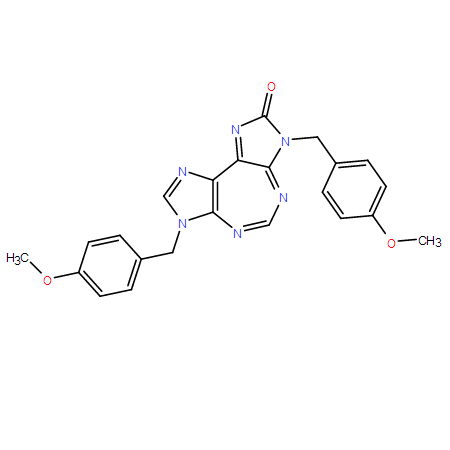| Cas No.: | 1070773-09-9 |
| Chemical Name: | RX33, RX 33 |
| Synonyms: | RX33, RX 33 |
| SMILES: | C1=C(OC)C=CC(CN2C3N=CN=C4N(CC5=CC=C(OC)C=C5)C(=O)N=C4C=3N=C2)=C1 |
| Formula: | C23H20N6O3 |
| M.Wt: | 428.16 |
| Sotrage: | 2 years -20°C Powder, 2 weeks 4°C in DMSO, 6 months -80°C in DMSO |
| Description: | RK-33 is an RNA helicase inhibitor against DDX3, and inhibits its helicase activity. |
| In Vivo: | There is more cell death (pyknotic or condensed nuclei) admixed with fibrin and interstitial edema in the tumors from mice from the combination RK-33 and radiation group compared to the control or single treatment groups. The treatment combination of RK-33 and radiation has an advantage in reducing tumor proliferation[1]. In the mice treated with RK-33-PLGA, RK-33 can be detected in the plasma (34 μg/mL) and liver (28 μg/g), but not lungs[2]. |
| In Vitro: | RK-33 shows inhibition of many kinds of cancer cells with IC50 of 3-6 µM, while PC3 is much less sensitive to RK-33 (IC50 >12 µM). RK-33 treatment causes a significant accumulation in the G1 phase for DU145 and LNCaP, although treatment with RK-33 causes only a moderate accumulation of the G1 phase for 22Rv1, and the treated cells have significantly reduced G2 phase. RK-33 treatment also causes 12 moderate G1 accumulation in 22Rv1[1]. RK-33-loaded NPs demonstrate cytotoxicity to MCF-7 cells in a dose-dependent manner, while equivalent doses of empty NPs have no killing effect. The IC50 value of 5% RK-33 loaded NPs is 49 μg/mL, and the IC50 value of 10% RK-33 loaded NPs is 25 μg/mL[2]. |

 DC Chemicals' products qualify for U.S. tariff exemptions. We guarantee no price increases due to customs duties and maintain stable supply, continuing to deliver reliable research solutions to our American clients.
DC Chemicals' products qualify for U.S. tariff exemptions. We guarantee no price increases due to customs duties and maintain stable supply, continuing to deliver reliable research solutions to our American clients.





















